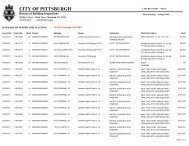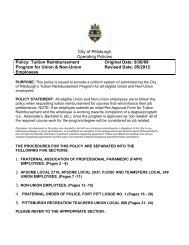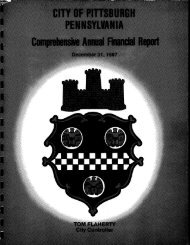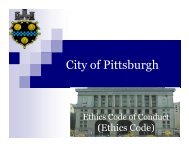east liberty station: realizing the potential - City of Pittsburgh
east liberty station: realizing the potential - City of Pittsburgh
east liberty station: realizing the potential - City of Pittsburgh
Create successful ePaper yourself
Turn your PDF publications into a flip-book with our unique Google optimized e-Paper software.
established mechanism <strong>of</strong> municipal debt.<br />
Within a larger district such as TRID, much<br />
<strong>of</strong> <strong>the</strong> incremental revenue flow would be<br />
speculative at <strong>the</strong> time <strong>of</strong> establishment.<br />
The amount <strong>of</strong> upfront financing available<br />
would be dependent upon only known<br />
projects within <strong>the</strong> TRID or not available<br />
until construction is completed. These<br />
challenges limit <strong>the</strong> ability to raise initial<br />
capital funding through a TRID backed<br />
public revenue bond issuance.<br />
Whe<strong>the</strong>r district-wide or project specific,<br />
TIF statutes across <strong>the</strong> country are<br />
constructed with <strong>the</strong> elimination <strong>of</strong> blight<br />
and community revitalization as primary<br />
goals. New development is expected<br />
to result in private investment and job<br />
creation. However, few TIF programs<br />
have a direct emphasis on single public<br />
policy goals such as TOD. TRID is unique<br />
in this regard with its promotion <strong>of</strong><br />
TOD and transit improvements through<br />
comprehensive, community based planning.<br />
The elTRID value capture strategy detailed<br />
below is driven by this specific policy as a<br />
means to facilitate revitalization within <strong>the</strong><br />
study area.<br />
TIF could applied in an effort to foster<br />
TOD led redevelopment throughout <strong>the</strong><br />
elTRID study area ei<strong>the</strong>r for specific sites<br />
or on a district-wide basis. Though, <strong>the</strong>re<br />
are several issues that limit <strong>the</strong> ability to<br />
implement TIF to achieve <strong>the</strong> development<br />
and infrastructure program outlined within<br />
this study. The <strong>City</strong> is limited in <strong>the</strong> value <strong>of</strong><br />
taxable property within active TIF districts.<br />
Adding <strong>the</strong> full proposed TRID Boundary<br />
to <strong>the</strong> existing parcels within TIF districts<br />
throughout <strong>the</strong> <strong>City</strong> would bring <strong>the</strong> URA<br />
close, if not over, <strong>the</strong> 10% statutory limit.<br />
Fur<strong>the</strong>r, utilizing TIF for larger specific sites<br />
would limit <strong>the</strong> cohesive strategy between<br />
projects and momentum built through<br />
decades <strong>of</strong> planning.<br />
TIF would also require a certification <strong>of</strong><br />
‘blight’ which is <strong>of</strong>ten contentious especially<br />
when including non-blighted parcels in a<br />
larger district. The legislative approval<br />
process for expanding a TIF boundary<br />
would be approximately twice as long<br />
per <strong>the</strong> terms <strong>of</strong> each Act. TRID can be<br />
utilized in areas regardless <strong>of</strong> <strong>the</strong> condition<br />
<strong>of</strong> property and <strong>the</strong> Act includes specific<br />
provisions for boundary expansion. With<br />
its focus on TOD principles and increased<br />
stakeholder participation, TRID is <strong>the</strong><br />
preferred development finance tool to<br />
facilitate revitalization within <strong>the</strong> study area.<br />
elTRID Value Capture Strategy<br />
Pursuant to Chapter 7 <strong>of</strong> <strong>the</strong> Act, a<br />
coterminous value capture area shall<br />
be simultaneously created at <strong>the</strong> time a<br />
specific TRID boundary is determined.<br />
Establishment <strong>of</strong> this value capture<br />
boundary allows <strong>the</strong> local taxing bodies<br />
and transit agency to share incremental<br />
tax revenues generated without in <strong>the</strong><br />
boundary to implement projects identified<br />
in <strong>the</strong> planning study. As discussed, <strong>the</strong><br />
value capture area essentially mirrors a 20<br />
year TOD specific TIF District with revenues<br />
dedicated to fund specific improvements<br />
and maintenance. However, revenues<br />
DRAFT<br />
may not be utilized by municipalities<br />
and counties for general government<br />
purposes or by transit agencies for capital<br />
improvements elsewhere in <strong>the</strong> system.<br />
elTRID Value<br />
Capture<br />
District-wide or<br />
Project Specific<br />
Improvements<br />
New Increment<br />
Created<br />
Value Capture<br />
Fund Increase<br />
97<br />
95<br />
GSP Consulting | Studio for Spatial Practice | Fitzgerald & Halliday
















